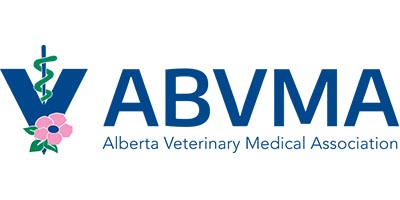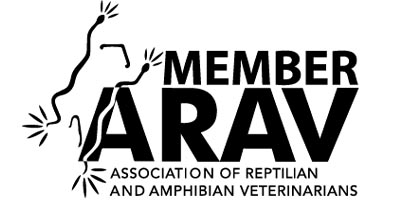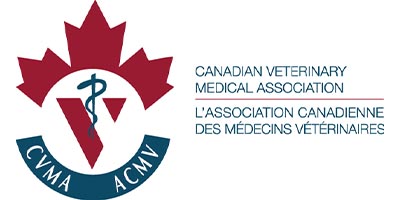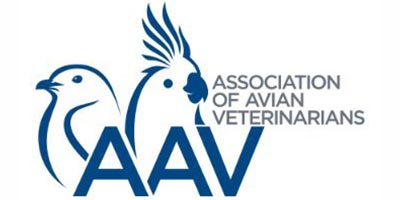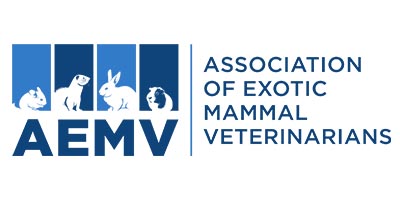The prehistoric nature and deliberate movements of a tortoise has made this gentle and interesting creature a desired pet, but care must be taken to invest in the proper housing, nutrition and care of these long-lived animals. All tortoises and turtles have basic common needs that include supplemental heat and lighting, proper substrate and specialized diets. A tortoise should always be handled gently, right side up. Sudden shifts in position can cause the internal organs to twist and rapid movements can cause stress and disorientation.
 HOUSING:
HOUSING:
An enclosure should be easy to clean, well ventilated, escape proof and have adequate light and heat. The living space should re-create the tortoise’s natural habitat and should be located in an area of the home that prevents stresses from noise or vibrations (televisions, stereos, high traffic areas), fumes (kitchens) and large fluctuations in temperature. Adequate space for the tortoise to move about is not only important for physical health but for the mental well being of the tortoise. It is easy to plan a terrarium for a tiny juvenile, but many adult tortoises grow to several kilos in weight and owners must be prepared to meet the necessary housing needs. Tortoises are adept climbers but poor swimmers, so care must be taken to ensure the set-up does not predispose the animal to drowning or overturning accidents.
As tortoises grow, moving from a small terrarium to a specially designed tortoise table will be necessary. The table not only allows for increased floor space, it allows for better ventilation and flexible lighting and heating arrangements. The visual barriers of the walls will decrease stress and help promote normal behaviour. Hide areas should be provided for all tortoises. Many are naturally shy and will become stressed and stop eating without refuge. Other tortoise species need a hide area over deep substrate so they can burrow to conserve water and remain hydrated.
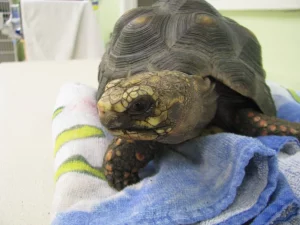 SUBSTRATE:
SUBSTRATE:
Substrate should be tailored to the species being housed, but in general, it should be deep enough to allow the tortoise to burrow and firm enough that the tortoise can easily walk without having to paddle through bedding. Substrate should be dust free, non-toxic and easy to clean. Do not use corncob bedding, kitty litter, sand only, wood shavings or gravel as these are often associated with impaction and toxicity. Aim to use a variety of substrates in the enclosure. Tiles, reptile carpet, or newspaper make an easy to clean feeding area and sterile sphagnum, peat moss, or combination play sand and soil allow for exercise, healthy feet and burrowing.
All turtles and tortoises are ectotherms, dependent on environmental temperature to regulate their body temperature. Ectotherms need to be able to raise and lower body temperature in order to digest food, grow, fight disease and reproduce. Proper heating, lighting and humidity are crucial to the health and well being of captive tortoises and tools such as thermometers and hygrometers are essential to ensure that the animal is neither under nor overheated.
Heat sources such as ceramic heat lamps, heating pads, or heating tape are preferred and all cords and bulbs must be secured and out of reach of the tortoise. Particular care must be taken not to overheat juveniles. All heat sources should provide both a daytime and nighttime temperature gradient, with appropriate microclimates within the enclosure.
ULTRAVIOLET LIGHTING:
All turtles and tortoises require a source of sunlight or UVB lighting daily, for 10-12 hours. Natural sunlight makes Vitamin D when the UVB rays hit the skin and Vitamin D works with calcium and phosphorus in the body to produce healthy skin, a strong shell, and helps stimulate the appetite and the immune system. Captive tortoises should be provided with a UVB light source by means of a special UVB bulb. Because both glass and plastic will filter out UVB rays, placing the enclosure near a window does not achieve Vitamin D production and may disrupt the temperature gradient in the enclosure. UVB bulbs should periodically be changed, according to manufacture recommendations as the essential rays degrade with time. Weather permitting and with the appropriate safety precautions, tortoises should be taken outside for exposure to natural sunlight.
FOOD AND WATER:
Food and water dishes should be accessible and cleaned daily. Dietary requirements can be specialized and complex and offering a wide range of food items is recommended, both to meet the nutritional requirements of the tortoise, but also to enrich its life through foraging and variety. Although commercial diets are available for some species of tortoise, these diets should only be used as a supplement to a balanced diet as they have yet to be adequately researched. Juveniles will have slightly different nutritional requirements than adults. A calcium (without additional Vitamin D3) supplement should be used daily in growing or reproducing tortoises and at least four times a week in non-reproducing adults. A multivitamin and mineral supplement can be used once every 7 – 10 days.
Water should be available at all times and in many cases, the water dish will also provide the turtle or tortoise with a place to soak. Many species will climb into the water pan to drink and defecate and for this reason, using a separate soaking pan outside of the enclosure makes cleaning easier. Warm soaks help prevent constipation and dehydration. The water level should never be above the animal’s chin (when the head is partially retracted), the water temperature warm, and the animal supervised at all times to prevent drowning accidents. Misting the enclosure to create ambient humidity should be confined to species requiring humidity. In species from arid climates, too much moisture, both in the environment and the diet, can result in illness.
 CLEANING AND DISINFECTING:
CLEANING AND DISINFECTING:
Substrate should be changed regularly, according to the size of the enclosure. When disinfecting, do not use products such as Lysol®, PineSol®, or Dettol® as these are poisonous to reptiles. The veterinary disinfectant, Virkon®, or diluted bleach and water are safe to use. Always rinse well and ensure fumes have dissipated before replacing the tortoise in the enclosure.
COMMON SIGNS OF ILLNESS
Sick turtles or tortoises may appear listlessness with limp limbs, swollen eyes, swollen ears, bubbling from the nostrils or may stop eating. Redness of the skin or changes to the shape, texture or colour of the shell may indicate illness. Any of these clinical signs warrants a visit to a veterinarian experienced in reptile care.
- Swollen eyes: May result from a lack of Vitamin A in the diet. Inadequate Vitamin A can lead to secondary bacterial infections and pneumonia. Both sight and smell are affected and the turtle typically stops eating. The vitamin deficiency needs to be corrected by injection and the infections treated with antibiotics.
- Soft shell: This is common in young, growing turtles that do not receive adequate calcium or vitamin D or receive an excess of phosphorous. The shell pits easily and is prone to infection and deformities. Medical and nutritional intervention are needed.
- Shell pyramiding: Abnormal growth of the scutes resulting in a pyramid effect to the top of the shell. Can be caused by dietary imbalances and environmental issues. Common in the Sulcatas.
- Egg binding: Female turtles can lay eggs without a male. The eggs are infertile, but their development still takes a heavy toll on the female. Turtles suffering from an inadequate diet, insufficient UV lighting or heat, or an underlying disease may be unable to successfully lay their eggs and this is defined as ‘egg binding’. This situation is life threatening and requires immediate veterinary intervention.
- Bacterial infections: Poor nutrition, inappropriate heating or humidity and poor sanitation compromises the immune system making the tortoise susceptible to bacterial infections. Correction of the environmental deficiencies and medical intervention are required.
- Gout / Kidney problems: An excess of protein, dehydration or improper water availability can lead to kidney problems.
- Respiratory infections: Pneumonia is common in turtles. Signs include nasal and ocular discharge, open mouth breathing, inappetence, and lethargy. Veterinary intervention is required.
- Swollen ears: Infection of the external ear canal is common and the swelling may appear on one or both sides of the turtle’s head. This is a painful infection and will affect the turtle’s desire to eat. Medical and surgical intervention is required.
- Shell rot/trauma: The shell is a living organ and susceptible to infection. Shell injuries and defects can lead to systemtic infections. If the shell changes in colour, texture, or strength, the tortoise should be seen by a veterinarian.
- Overgrown beak: Abnormal wearing patterns can sometimes result in an abnormally formed upper beak. This can affect eating and result in mouth infections. Trims should be done by a veterinarian.
- Parasites: Many turtles are infected by internal parasites. Consult a veterinarian to determine a deworming protocol.
- Salmonella: All pet reptiles may carry the bacteria Salmonella, which can cause disease in humans. We recommend reading our handout on Salmonella.
SPECIFIC SPECIES CARE
COMMON BOX AND THREE TOED BOX TURTLE / Terrapene Carolina
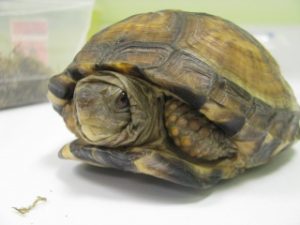 Box turtles are common pets and are native to the United States and Mexico. They are land dwelling, but will enter the water for drinking and soaking. Box turtles have a unique hinge located in the middle of the plastron (bottom shell) that allows the turtle to pull in its head and appendages and close the shell tightly. The male has a long, thick tail, with the vent opening half to two thirds the way down. The dark purple phallus (sex organ) can often be seen protruding from the vent opening. The female has a shorter, thinner tail with the vent opening near the base. Males have a bright red iris; in females, it is yellow-brown. Box turtles can be long lived and typically grow 5-7 inches in length and adult weights can range from 225-450 grams. Box turtles may attempt to hibernate, but unless well planned for, hibernation can predispose the turtle to disease.
Box turtles are common pets and are native to the United States and Mexico. They are land dwelling, but will enter the water for drinking and soaking. Box turtles have a unique hinge located in the middle of the plastron (bottom shell) that allows the turtle to pull in its head and appendages and close the shell tightly. The male has a long, thick tail, with the vent opening half to two thirds the way down. The dark purple phallus (sex organ) can often be seen protruding from the vent opening. The female has a shorter, thinner tail with the vent opening near the base. Males have a bright red iris; in females, it is yellow-brown. Box turtles can be long lived and typically grow 5-7 inches in length and adult weights can range from 225-450 grams. Box turtles may attempt to hibernate, but unless well planned for, hibernation can predispose the turtle to disease.
-
Temperature range day 26-30°C / 78-89°F
-
Temperature range night 21-26°C / 70-78°F
-
Ultra violet light source 10-12 hours/day (filtered through plastic plants)
-
Relative humidity Readily available soaking pan, humid microclimates
-
Well ventilated
Box turtles are omnivores, eating both plant and animal matter. Adult turtles should be fed at least three times a week, juveniles fed daily. A balanced diet consisting of 50% plant or animal protein and 50% vegetable/fruit (with more vegetable than fruit offered) is ideal. Meals should be offered in a mixed salad fashion to help prevent the turtle from selective eating. Food should be served at room temperature and gently misting with water can encourage eating and provide the turtle with additional water.
Protein sources can include pet store purchased earthworms, crickets, grasshoppers, slugs, mealworms, waxworms, other insects, trout chow, whole chopped sardines or smelt, alfalfa based rabbit or rodent pellets.
Vegetable/fruit sources can include tomatoes, strawberries, raspberries, mango, papaya, melons, apples, grapes, figs, cherries, peaches, pears, all dark leafy greens such as mustard or collard greens, radish and turnip tops, kale, cabbage, escarole, dandelion leaves and flowers, nasturtiums, geraniums, rose petals, prickly pear cactus flowers, squashes, cooked sweet potato, thawed frozen mixed vegetables (carrots, corn, peas, beans), alfalfa, radish, or clover sprouts, pea pods. Avoid over feeding greens high in oxalates (spinach, beet greens) as these can bind with calcium and render the diet calcium deficient. Avoid over feeding cabbage, kale, or brussel sprouts as these can lead to goiter formation.
 SULCATA TORTOISES (AFRICAN SPURRED TORTOISE / Geochelone sulcata
SULCATA TORTOISES (AFRICAN SPURRED TORTOISE / Geochelone sulcata
The Sulcata tortoises originate from the driest part of Africa. Voracious eaters, they grow rapidly with adults reaching weights of 25-45 kg and growing to over 2.5 feet in length. Sulcatas can live over 70 years and require a large living space with plenty of room to roam. Sulcatas are good climbers and can easily overturn so care must be taken. Sulcatas need a hot and dry environment and climate permitting, should spend part of the year in an outdoor enclosure. They do not hibernate. Sulcatas are easily chilled and too much moisture can lead to skin, shell and kidney problems. In nature, the Sulcata will spend a large portion of the day burrowed in its den or in a mud wallow to keep cool.
- Day time temperatures should range from 75–88°F / 24-31°C
- Basking temperature 95-105°F / 35-40°C
- Night time temperatures can drop to low 70’s°F / 21-26°C
- UVB lighting must be provided
- Enclosure must be kept dry and a den box for burrowing must be provided
- Substrate should be solid enough to provide good traction when walking
- Sulcatas have a large requirement for fiber. The bulk of the diet should be grasses, weeds, and non-legume hays (timothy, oat, brome, orchard grass). Cactus fruit, plantain, nasturtiums, geraniums and hibiscus flowers and the occasional fruit treat of strawberries, cantelope or banana (with peels) may be used sparingly. Caution must be taken not to over feed legume hays (alfalfa) or dandelion greens, wet leafy vegetables (leafy greens, collard greens, etc), oxalate rich vegetables (spinach, parsley, beet greens), or fruit. Commercial tortoise chows can supplement the diet.
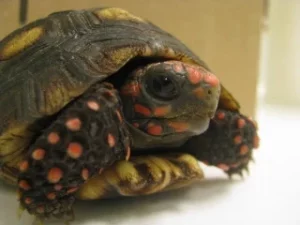 REDFOOT TORTOISE / Geochelone carbonaria
REDFOOT TORTOISE / Geochelone carbonaria
The Redfoot is a native of South America’s grass and forestland. Primarily herbivorous, the Redfoot has been known to eat carrion in the wild. Also an avid climber, the Redfoot benefits from being outside in the warmer months.
- Day time temperature range 70–75°F / 21–24°C
- Basking area of 85–88°F / 29–31°C
- Night time temperature range 70’s°F / 20–21°C with available heat source
- UVB lighting is required
- A large shallow pan for soaking should be available
- Substrate of peat moss and sand with a hide box / burrow area embedded into the substrate to create a humid box is ideal
- Diet as per Box Tortoises
 LEOPARD TORTOISE / Geochelone pardalis
LEOPARD TORTOISE / Geochelone pardalis
Native to semi-arid grasslands in Africa, the Leopard Tortoise can live 50 -100 years, grow 10-18 inches in length and weigh over 35 kg. Leopard tortoises graze on a variety of grasses and vegetation. They require a high-fiber diet rich in calcium and the bulk of the diet should be grasses, weeds, and non-legume hays (timothy, oat, brome, orchard grass). The captive diet may be supplemented a couple times a week with collard greens, turnip greens, mustard greens, dandelion greens and flowers, hibiscus leaves and flowers, grape leaves, escarole, mulberry tree leaves, spineless cactus pads (Opuntia spp.), carrots, zucchini, butternut squash, pumpkin, mushrooms, sweet potato, yellow squash, and bell peppers. Commercially formulated diets can be included. A small portion of the leopard tortoise’s diet may include fruits, such as tomatoes, apples, papayas, cantaloupe, honeydew, watermelon, strawberries, raspberries, grapes, mangos and bananas. Fruit should be no more than about 5 percent of the overall diet. Care must be taken not to over-feed wet foods or fruit.
- Day time temperature range 72–86°F / 22–30°C
- Basking area of 95°F / 35°C
- Night time temperature range 70’s°F / 20–21°C with available heat source
- UVB lighting is required
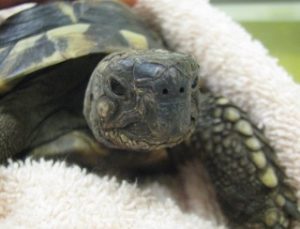 HERMANN’S TORTOISE / Testudo g. hermanni
HERMANN’S TORTOISE / Testudo g. hermanni
From the Mediterranean, this is a hardy tortoise that can live several decades and grows 6-8 inches in length.. Hermann’s tortoises need a dry substrate and are primarily herbivores. Vegetable/fruit sources can include tomatoes, strawberries, raspberries, mango, papaya, melons, apples, grapes, figs, cherries, peaches, pears, all dark leafy greens such as mustard or collard greens, radish and turnip tops, kale, cabbage, escarole, dandelion leaves and flowers, nasturtiums, geraniums, rose petals, prickly pear cactus flowers, squashes, cooked sweet potato, thawed frozen mixed vegetables (carrots, corn, peas, beans), alfalfa, radish, or clover sprouts, pea pods. Avoid over feeding greens high in oxalates (spinach, beet greens) as these can bind with calcium and render the diet calcium deficient. Avoid over feeding cabbage, kale, or brussel sprouts as these can lead to goiter formation.
- Day time temperature range 82–86°F / 27–30°C
- Basking area of 95°F / 35°C
- Night time temperature range 70’s°F / 20–21°C with available heat source
- UVB lighting is required
- Microclimates within the enclosure
 Is your species of tortoise not listed? Check out www.tortoisetrust.org or www.reptilesmagazine.com
Is your species of tortoise not listed? Check out www.tortoisetrust.org or www.reptilesmagazine.com
It is recommended that all tortoises receive an annual health examination by a veterinarian experienced in reptile care. Yearly exams allow early detection of disease and allow a chance to update owners on the latest in care and husbandry of their pet.
THIS INFORMATION IS MEANT AS A GUIDELINE ONLY AND IN NO WAY REPLACES CONSULTATION WITH A VETERINARIAN.


